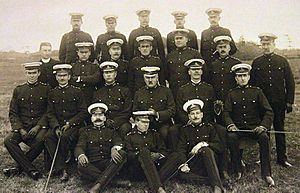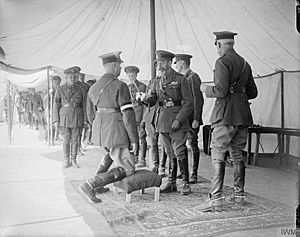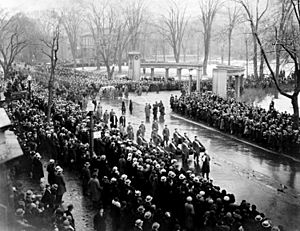Arthur Currie facts for kids
Quick facts for kids
Sir Arthur Currie
|
|
|---|---|

Currie in 1917
|
|
| Nickname(s) | "Guts and Gaiters" |
| Born | 5 December 1875 Napperton, Ontario |
| Died | 30 November 1933 (aged 57) Montreal, Quebec |
| Buried |
Mount Royal Cemetery, Montreal, Quebec
|
| Allegiance | Canada |
| Service/ |
Canadian Militia Canadian Expeditionary Force |
| Years of service | 1897–1920 |
| Rank | General |
| Commands held | Inspector General of the Armed Forces (1919–1920) Canadian Corps (1917–19) 1st Canadian Division (1915–17) 2nd Canadian Brigade (1914–1915) |
| Battles/wars | World War I |
| Awards | Knight Grand Cross of the Order of St Michael and St George Knight Commander of the Order of the Bath Mentioned in Despatches (9) Chevalier of the Legion of Honour (France) Croix de guerre (France) Knight of the Order of the Crown (Belgium) Croix de guerre (Belgium) Distinguished Service Medal (United States) |
| Other work | Established Khaki University, President & Vice-Chancellor of McGill University |
General Sir Arthur William Currie (December 5, 1875 – November 30, 1933) was a top officer in the Canadian Army during World War I. He started as a part-time soldier and rose to become the first Canadian commander of the Canadian Corps. Currie was known for quickly adapting his battle plans to the tough conditions of trench warfare. He is seen as one of the best commanders on the Western Front and in Canadian military history.
Currie began his military journey in 1897 as a part-time soldier. He also worked as a teacher, then an insurance salesman, and later in real estate. He quickly moved up the ranks, becoming an officer in 1900 and a major in 1906. By 1909, he commanded an artillery regiment. In 1913, he took charge of the new 50th Regiment Gordon Highlanders of Canada. When World War I began, he was appointed commander of the 2nd Canadian Brigade. After the Second Battle of Ypres, he was promoted to major-general and led the 1st Canadian Division. Following the Battle of Vimy Ridge, Currie became lieutenant-general and took command of the Canadian Corps. After the war, he was promoted to general and became Inspector General of the Canadian Army. Even though he only had a high school diploma, Currie became the head of McGill University in 1920, a role he held until his death in 1933.
Contents
Arthur Currie's Early Life
Arthur Currie was born on December 5, 1875, on a farm near Napperton, Ontario. He was the third of eight children. His grandparents had moved from Ireland in 1838.
Currie went to local schools and Strathroy District Collegiate Institute. He was a good student, especially interested in literature. He wanted to study law or medicine. However, his father died when Arthur was fifteen, making it hard to afford university. Currie trained as a teacher instead.
In 1894, he left high school and moved to British Columbia. He hoped to find work there because of the new transcontinental railway. He became a teacher in British Columbia. In 1896, Currie moved to Victoria, British Columbia, teaching at Boy's Central School and later Victoria High School.
Joining the Military
On May 6, 1897, Currie joined the Canadian Militia as a part-time gunner. He was part of the 5th (British Columbia) Field Artillery Regiment. He became a corporal in 1900 and then an officer. Being an officer meant higher social status in Victoria.
Currie took his military role seriously. He attended many courses and read military books. He was a skilled marksman. He was promoted to captain in 1901 and major in 1906. By September 1909, he was a lieutenant-colonel, commanding the 5th Regiment. Currie was also an active Freemason. He was also president of the Young Men's Liberal Association of Victoria.
Currie also worked in business. In 1904, he became head of the Matson Insurance Firm. He also invested a lot in real estate. His financial situation became difficult in 1913 when property prices dropped. His term as commander of the 5th Regiment was ending. At this time, he was asked to lead a new militia regiment.
After the Canadian federal election of 1911, Minister of Militia and Defence Sam Hughes wanted to expand the army. A new Highland regiment was formed in Victoria in 1913. Currie was asked to command it. He initially said no, but his friend Major Garnet Hughes convinced him to accept. Currie qualified for the role in March 1914.
When World War I started on August 4, 1914, Currie was offered command of the 2nd Infantry Brigade. This brigade was part of the Canadian Expeditionary Force's 1st Canadian Division. He accepted and was promoted to brigadier-general on September 29, 1914. He took command of the 2nd Brigade at the Valcartier Camp in Quebec. In October 1914, he sailed overseas with his brigade.
World War I Leadership
Brigade Commander at Ypres
The Canadian 1st Division trained in England during the winter of 1914–15. They were sent to France in February 1915. They took control of a trench section in the Ypres Salient on April 17, 1915. Five days later, the Germans used poison gas for the first time. French troops on the Canadians' left side broke, leaving a large gap.
In the confusion, Currie showed strong leadership. He calmly gave orders from his headquarters, even as it was attacked. He quickly organized a defense and counterattacked. After several days of intense fighting, the Allies stopped the German advance. Currie's 2nd Brigade held its ground, despite heavy losses.
After the battle, Currie was promoted to major-general. He was given command of the entire First Canadian Division. He also received important awards like the Companion of the Order of the Bath and Commander of the Legion d'Honneur.
Leading a Division
The Canadians joined the Battle of the Somme in the fall of 1916. Currie became known for his skill in planning attacks. These attacks aimed to take small areas and then defend them against German counterattacks.
By late 1916, all four Canadian divisions were in France. They formed the Canadian Corps, led by Sir Julian Byng. The British High Command decided the Canadians would play a key role in the upcoming Battle of Arras. Their mission was to attack Vimy Ridge. Byng asked Currie to study past battles and suggest improvements. Currie also learned from French officers about their experiences at the Battle of Verdun.
Currie, leading the 1st Canadian Division, was in charge of the southern part of the Canadian Corps' attack. The attack began at 5:30 AM on Easter Monday, April 9, 1917. By the end of the first day, Currie's division had captured all its first goals. The next morning, they continued to advance. By 2:00 PM, the 1st Canadian Division secured its final objective.
Commanding the Canadian Corps
In June 1917, Byng was promoted. Currie was then promoted to lieutenant-general and given command of the entire Canadian Corps. King George V knighted Currie on July 12, 1917.
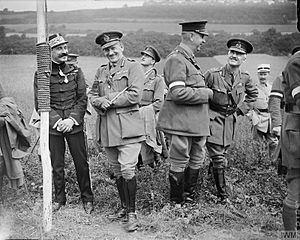
The Canadian Corps was ordered to attack the city of Lens in July 1917. Currie suggested a different plan. He proposed taking the high ground outside the city, known as Hill 70. His plan was to hold this position and use artillery to cause heavy losses to German counterattacks. Currie's plan worked well. About 20,000 Germans were killed or wounded, while 9,000 Canadians were lost. This operation stopped German forces from moving to other battle areas.
The Canadian Corps then moved to Ypres for the Battle of Passchendaele. Currie was tasked with continuing the advance to capture Passchendaele village. He planned a series of careful, sharp attacks. This allowed the Corps to take an objective and then defend it against German counterattacks. By October 30, the Canadians reached the village outskirts. They held their ground for five days in heavy rain and mud. The Canadians won, but at a cost of 15,654 casualties. Currie's prediction of casualties was accurate.
The War's Final Push
By early 1918, the Canadian Corps faced changes. Currie fought to keep the Corps' unique Canadian structure. He believed it was best for the soldiers. He succeeded, and the Canadian Corps fought as a strong, united force during the Hundred Days Offensive.
On March 21, 1918, the Germans launched a major attack. But by summer, the Allies were ready to counterattack. In August 1918, Currie moved the Corps south to Amiens. They kept their movements secret to surprise the Germans. The attack on August 8 was a great success.
The Canadians then moved to the Somme. They attacked the Hindenburg Line on September 2. This attack broke through the German lines. Historians called this a major achievement. Currie was praised for his use of artillery and flexible infantry. The German army then retreated.
Currie planned another bold move: crossing the flooded Canal du Nord. On September 27, the entire Corps crossed the canal. They moved through German lines using zig-zag tactics to confuse them. The Germans were tired and retreated for five weeks. On November 10, Currie ordered his troops to liberate Mons. On November 11, as Currie received orders for a general armistice at 11:00 AM, the capture of Mons was completed.
After the war, Currie set up the Canadian War Narrative Section. This helped record the achievements of the Canadian Corps. It also helped improve Currie's public image.
After the War
Currie and his family returned to Canada in August 1919. Currie was appointed Inspector General of the Armed Forces. He was promoted to full general on December 10, the highest rank in the Canadian forces. He wanted to reform the military. However, military funding was cut after the war. Currie faced strong opposition to his changes.
Unhappy with the situation, Currie retired from the military. In May 1920, he accepted the job of principal and vice-chancellor of McGill University in Montreal.
Leading McGill University
Currie only had a high school diploma. But he was chosen to lead McGill University because of his "exceptional powers of organization and administration." He was also praised for his "capacity for inspiration and leadership."
Soon after his appointment, Currie led a fundraising campaign for the university. He traveled across Canada, asking for support. The campaign raised $6.5 million, more than its goal. Currie became known as a top university administrator. He helped establish new faculties at McGill, including the Faculty of Music. He also saved the School for Graduate Nurses from closing. During his time, McGill doubled its income despite the Great Depression.
Currie's Death
Currie suffered a stroke on November 5, 1933. He died on November 30 at age 57 from lung problems. His funeral on December 5 in Montreal was the largest in Canadian history at that time. About 150,000 people watched the procession. The funeral was broadcast on radio. Many important people attended, including the Governor General of Canada.
Currie was first buried in a family plot. Three years later, his remains were moved to a more prominent site. Currie was survived by his wife, Lucy, and a son and daughter. In 1935, the Canadian government gave $50,000 to his family to recognize his service.
Honours and Tributes
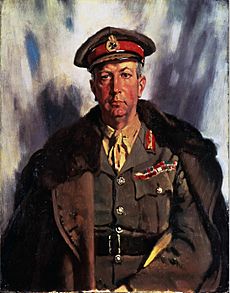
Currie received many honours for his service. He was made a Companion of the Order of the Bath in 1915. He was promoted to Knight Commander of the Order of the Bath in 1918. In 1919, he became a Knight Grand Cross of the Order of St Michael and St George. He was also mentioned in official reports nine times during the war.
Currie also received awards from other countries. These included the French Légion d'honneur and Croix de guerre. He also received the Belgian Croix de guerre and Order of the Crown. The United States awarded him the Distinguished Service Medal. Currie received 19 honorary degrees for his war efforts and work in education.
Many places and things are named after Currie. These include General Currie Elementary School in Richmond, British Columbia. There is also a Sir Arthur Currie Elementary School in Montreal. Mount Currie in Banff National Park is named after him. The Currie Barracks in Calgary (now CFB Calgary) was named in his honour.
In 1934, Currie was recognized as a Canadian Person of National Historic Significance. The Currie Building and Currie Hall at the Royal Military College of Canada are named after him. In Victoria, the street where he lived was renamed Arthur Currie Lane. A building at the University of Victoria is also named in his honour. In Strathroy, Ontario, the local Royal Canadian Legion branch bears his name, and a statue has been raised to him. In 2006, Canada honored Currie as one of fourteen Canadians in the Valiants Memorial. He is one of five people with a life-sized statue there.
Currie's Legacy
Canadian historians, like Pierre Berton and Jack Granatstein, consider Currie to be Canada's greatest military commander. He was a large man, over six feet tall. His troops called him "Guts and Gaiters." He was a brilliant tactician. He used his skills to reduce casualties and helped end the war faster.
Historian Jack Hyatt said, "His slogan was, 'Pay the price of victory in shells—not lives,' and if he did anything heroic it was that." An article in Maclean's described his leadership: "No flashing genius, but a capable administrator, cool headed and even tempered and sound of judgment." He was known for listening to his staff and choosing the best plans.
See Also
- List of Canadian generals
Images for kids
-
Currie's funeral monument in Mount Royal Cemetery



